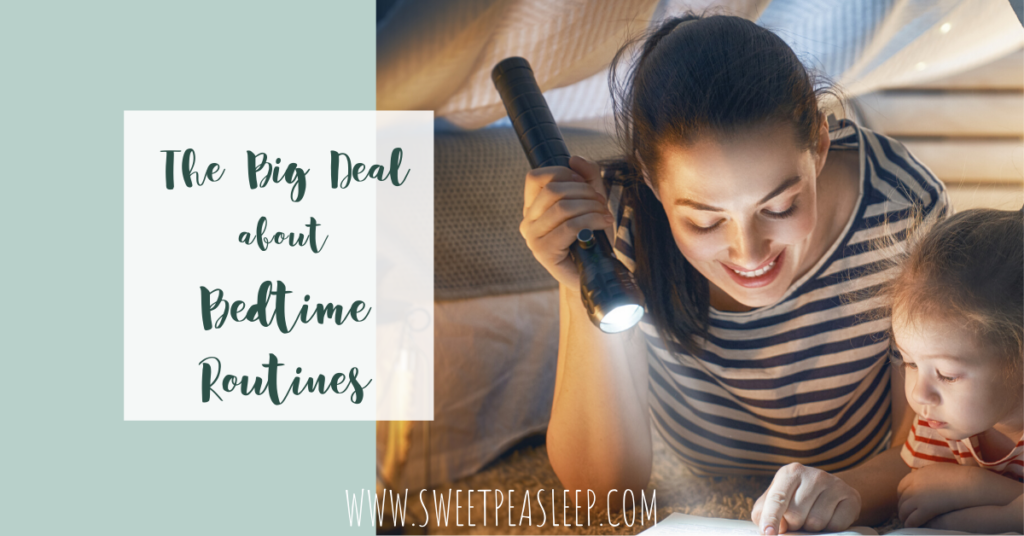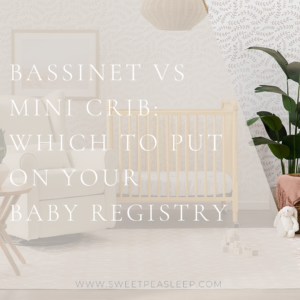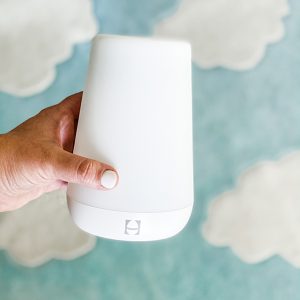
“Yeah, yeah, yeah, bedtime routines are important.”
…I know you’ve heard it a million times, and really, you want less patronizing sleep advice than “take a bath and read three books!”
I get it! And it can be tough to keep a bedtime routine intact, especially if your family is busy at night, you have multiple little ones to take through a routine, or you’re just so darn tired by the end of the day to bother with anything structured. I’ve also heard many parents express that they “tried a bedtime routine, and it didn’t work,” meaning that it didn’t help their little ones sleep through the night. It’s true that a bedtime routine in and of itself is typically not a magic bullet to get your child sleeping perfectly, but it is a crucial piece of the puzzle to great sleep hygiene (which in turn improves sleep!) I hope in this post I can convince you of the importance and value of taking the time to follow a solid routine, and provide some examples of routines that can work for ANY family!
Why is a bedtime routine important?
According to a study conducted by well-known child sleep researcher Jodi Mindell, “…Research demonstrates that… everyday routines are associated with positive child outcomes, including enhanced language development, academic achievement, and social-emotional and behavioral functioning. Everyday routines can also benefit family functioning, with some research indicating that routines are associated with higher levels of marital satisfaction and lower levels of maternal distress.”
According to an analysis from United Kingdom based public health company, BMC Public Health, “Studies have consistently showing that better quality bedtime routines are associated with better sleep quality and duration for both adults and children.”
In addition, a predictable routine can serve as a conditioning cue for children that “sleep is coming” and cause their body to naturally begin to wind down and feel sleepy. Just as with Pavlov’s dogs whose mouths salivated when they heard the bell, your little one is likely to start feeling drowsy when they are conditioned to know that sleep will soon be following reading books while cuddling in bed with the lights low. In turn, this makes bedtime easier and calmer for everyone!
If an easier bedtime, better quality sleep, longer sleep duration, improved academic achievement, language development, behavioral and emotional outcomes, better family attachment and overall functioning sounds like somethingIf you’re wondering exactly how to implement this beneficial habit, read on!
How old does my child need to be to implement a routine?
Truly, when you come home from the hospital, a simple routine is entirely appropriate! Babies start learning patterns very quickly and from a very young age, and a routine can be a nice way for parents to bond with baby and feel a small sense of comfort and structure during a time when things tend to be very flexible and unstructured! Studies have concluded that, when it comes to bedtime routines “the younger started, the better.”
What time should I start my routine?
An appropriate bedtime for any child is typically between 7:00 and 8:30pm. Start bedtime routine about 30 minutes before bedtime. On nights when a bath is included, you might want to start 45 minutes ahead of time. Unsure of your child’s appropriate bedtime? Use my free schedule calculator to find out!
What should our bedtime routine include?
A solid bedtime consists of four components:
- Nutrition
- Hygiene
- Communication
- Physical Contact
Let’s start with nutrition. With the exception of newborn babies who still tend to eat every could to several hours through the night, we all go longer through the night without eating than we do through the day. It’s always good to make sure our kiddos are going to sleep with full bellies. So at the beginning of the routine it is a good time to bottle feed, breastfeed, or offer a small protein-filled snack like a string cheese or crackers and nut butter. Many families who are having trouble with sleep find that moving the last bottle or breast feed to the beginning of the routine is key in helping their children not be reliant on sucking to sleep.
Following nutrition is hygiene. This is usually where parents give a bath. I find that my boys love to splash around in a nice warm bath most nights (it’s also my best tip for getting through witching hour!) However, if you give a bath some nights, it doesn’t have to be given every night! In some instances, such as with a child with eczema, it may be inadvisable to give a bath often. In that case, just make sure you wash their hands and face well. If your baby has teeth, wipe them with a soft, clean, damp cloth. If your child is old enough to brush their teeth, guide them through brushing their teeth. While you don’t need to give a bath, I always suggest making sure they have fresh, clean pajamas on. When a child wears their clothes from the day into bed, it spreads all of the allergens they may have picked up that day onto their pillow and bedding.
Once your child has had a bath or washed their hands, brushed their teeth and gotten into clean jammies, we move into the communication part of the routine. For many families, this includes a couple minutes talking about the child’s day, family prayers if you typically say prayers, and then reading books. I recommend that you have a typical amount of books that you read (e.g. 3 books per night) so that it keeps haggling over the number of books to a minimum. Make sure you’re taking this handful of minutes to be really present with your child, put your phone away and connect with them.
Finally, physical contact is offering the snuggle, hug and kiss to let your child know you love them and are always nearby.
Wait… shouldn’t putting them to sleep be a part of the routine?
If it works for you, yes! If you are assisting your child to sleep and you are all getting good sleep, then that is awesome, and you do what works for you, mama!
Time and time again, research has shown that a main predictor of struggling to fall asleep and frequent night wakings is parental presence at the time of falling asleep. If they need you to be there helping them fall asleep at bedtime, most likely, they will be calling for you to help you put them to sleep again in the middle of the night when they have those biologically normal wakings that are a part of everyone’s sleep cycles!
As parents of multiple children know well, having more than one child can make this a complication in and of itself! If two or more kids need your constant presence and physical help to get to sleep, you are in for a long bedtime, someone’s going to bed late, and you may be going from room to room trying to supervise causing tears and strife.
This can also set them up for a lot of upset if you happen to not be there for bedtime, for instance if you are at an event and hire a babysitter.
After you have implemented the routine, met their nutrition and hygeine needs, connected with them emotionally, spent some quality time, and helped them get mentally and physically ready for bed, you can absolutely kiss them goodnight, remind them that you’re nearby, and that it’s time for them to fall asleep on their own (with the exception of newborns- this probably won’t be in their skill set yet!)
Need help teaching your child the skill of falling asleep independently? Click here to see how we can work together to make this a reality!
What should I NOT include in my bedtime routine?
Look, I am not here to judge those nights that you just can’t even. You know those nights. Your spouse is working late, the kitchen is a mess from dinner, the baby needs to be fed and your toddler is hanging from the fifth shelf of the pantry trying to reach the Halloween candy. I know that sometimes it’s just easier to set them up with the iPad for 15 minutes so no one needs an urgent care visit tonight. However, in the interest of knowing the full picture, it is not recommended to watch TV or use screen devices for a full two hours before bedtime. Blue light from screens causes suppression of the production of melatonin, the hormone that helps your body get sleepy at night. Whenever possible, you should keep screens out of your bedtime routine.
Also, rough and tumble play like running around and wrestling (looking at you, dads! 🙂 ) is healthy, fun, and highly encouraged during the day, but right before bedtime isn’t a great time to get the adrenaline pumping, so try to save those activities for earlier if possible. Right before dinner is a great time to spend some energy and work up an appetite!
What should a bedtime routine look like for my family?
Example bedtime routine for a newborn:
- Nurse
- Burp
- Fresh diaper
- Fresh jammies
- Turn off light, turn on white noise
- Swaddle
- Song/cuddle/rock (you can always practice and try to let them fall asleep on their own in their bassinet or crib once they’re drowsy, but if they are upset by this, it is also completely appropriate to help them to sleep!)
- Into bassinet/crib
Example bedtime routine for 8 month old:
- Nurse or bottle
- Bath time
- Lotion up and fresh diaper
- Jammies
- Read two board books
- Turn off light, turn on white noise
- Sleep sack
- Say prayers
- Kiss and cuddle
- Into crib awake
Example bedtime routine for 3 year old:
- Bath time (I actually sometimes offer my son a snack in the bath! Is that weird? lol)
- Brush teeth
- Last chance for potty
- Pull Up and jammies
- Pick out 2-3 books
- Say prayers
- Lights down low, sound machine on
- Read books in bed
- Kiss goodnight
Example bedtime routine with two or more children
- Joint bath time and teeth brushing
- Have jammies laid out for older child so that they can put them on while you’re changing the younger child
- If they’re both/all old enough to have book preferences, let them each pick out one or two books.
- Read and say prayers together
- Each parent takes one child to tuck in OR if parenting solo, I recommend putting the older child down first and then attending to the younger child. If they have staggered bedtimes, set the older child up in a safe environment (preferably a room that is baby proofed with a baby gate) with books, stickers, Water Wow books, Play Doh, or some other activity while you attend to the younger child. If each parent typically takes a different child, I recommend switching off every night or two so you get to spend a couple minutes of quality time with each child, and so your children don’t get rigid about which parent is “allowed” to put them to sleep.
What if we don’t have time for the routine, or we don’t have time every night for one of the components?
An abbreviated version of the routine is perfectly sufficient on occasional nights where you’re out late or parenting solo and don’t have time to complete the routine with multiple kids. Skip bath, make sure they have fresh pajamas, brush teeth and let them know ahead of time that it’s late and there’s only one book tonight (it never hurts to promise a few extra books tomorrow to make up for it!)
So, there you have it! I hope this answered all of your questions about bedtime.
Did I miss anything? Let me know in the comments!
Katelyn










